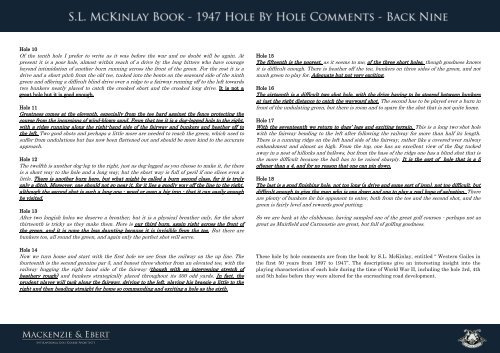Create successful ePaper yourself
Turn your PDF publications into a flip-book with our unique Google optimized e-Paper software.
Hole 10<br />
Of the tenth hole I prefer to write as it was before the war and no doubt will be again. At<br />
present it is a poor hole, almost within reach of a drive by the long hitters who have courage<br />
beyond intimidation of another burn running across the front of the green. For the rest it is a<br />
drive and a short pitch from the old tee, tucked into the bents on the seaward side of the ninth<br />
green and offering a difficult blind drive over a ridge to a fairway running off to the left towards<br />
two bunkers neatly placed to catch the crooked short and the crooked long drive. It is not a<br />
great hole but it is good enough.<br />
Hole 11<br />
Greatness comes at the eleventh, especially from the tee hard against the fence protecting the<br />
course from the incursions of wind-blown sand. From that tee it is a dog-legged hole to the right,<br />
with a ridge running along the right-hand side of the fairway and bunkers and heather off to<br />
the left. Two good shots and perhaps a little more are needed to reach the green, which used to<br />
suffer from undulations but has now been flattened out and should be more kind to the accurate<br />
approach.<br />
Hole 12<br />
The twelfth is another dog-leg to the right, just as dog-legged as you choose to make it, for there<br />
is a short way to the hole and a long way, but the short way is full of peril if one slices even a<br />
little. There is another burn here, but what might be called a burn second class, for it is truly<br />
only a ditch. Moreover, one should not go near it, for it lies a goodly way off the line to the right,<br />
although the second shot is such a long one - wood or even a big iron - that it can easily enough<br />
be visited.<br />
Hole 13<br />
After two longish holes we deserve a breather, but it is a physical breather only, for the short<br />
thirteenth is tricky as they make them. Here is our third burn, again right across the front of<br />
the green, and it is none the less daunting because it is invisible from the tee. But there are<br />
bunkers too, all round the green, and again only the perfect shot will serve.<br />
Hole 14<br />
Now we turn home and start with the first hole we see from the railway on the up line. The<br />
fourteenth is the second genuine par 5, and honest three-shotter from an elevated tee, with the<br />
railway hugging the right hand side of the fairway (though with an intervening stretch of<br />
heathery rough) and bunkers strategically placed throughout its 500 odd yards. In fact, the<br />
prudent player will tack along the fairway, driving to the left, playing his brassie a little to the<br />
right and then heading straight for home so commanding and exciting a hole as the sixth.<br />
Hole 15<br />
The fifteenth is the poorest, as it seems to me, of the three short holes, though goodness knows<br />
it is difficult enough. There is heather off the tee, bunkers on three sides of the green, and not<br />
much green to play for. Adequate but not very exciting.<br />
Hole 16<br />
The sixteenth is a difficult two shot hole, with the drive having to be steered between bunkers<br />
at just the right distance to catch the wayward shot. The second has to be played over a burn in<br />
front of the undulating green, but there is room and to spare for the shot that is not quite home.<br />
Hole 17<br />
With the seventeenth we return to dogs’ legs and exciting terrain. This is a long two-shot hole<br />
with the fairway bending to the left after following the railway for more than half its length.<br />
There is a cunning ridge on the left hand side of the fairway, rather like a covered-over railway<br />
embankment and almost as high. From the top, one has an excellent view of the flag tucked<br />
away in a nest of hillocks and hollows, but from the base of the ridge one has a blind shot that is<br />
the more difficult because the ball has to be raised sharply. It is the sort of hole that is a 5<br />
oftener than a 4, and for no reason that one can pin down.<br />
Hole 18<br />
The last is a good finishing hole, not too long (a drive and some sort of iron), not too difficult, but<br />
difficult enough to give the man who is one down and one to play a real hope of salvation. There<br />
are plenty of bunkers for his opponent to enter, both from the tee and the second shot, and the<br />
green is fairly level and rewards good putting.<br />
So we are back at the clubhouse, having sampled one of the great golf courses - perhaps not as<br />
great as Muirfield and Carnoustie are great, but full of golfing goodness.<br />
These hole by hole comments are from the book by S.L. McKinlay, entitled “ <strong>Western</strong> <strong>Gailes</strong> in<br />
the first 50 years from 1897 to 1947”. The descriptions give an interesting insight into the<br />
playing characteristics of each hole during the time of World War II, including the hole 3rd, 4th<br />
and 5th holes before they were altered for the encroaching road development.


